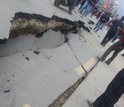Hola amigos: A VUELO DE UN QUINDE EL BLOG., hemos recibido información de la Fundación Nacional de Ciencias de Los Estados Unidos, cuyos científicos no descartan nuevos terremotos en Nepal, justo habrá una Conferencia para tratar de este tema.
More information...
Annual Geological Society of America meeting features NSF-supported earthquake research
 Credit and Larger Version |
Will there be another earthquake in Nepal?
Geoscientists funded by the National Science Foundation (NSF) are studying the devastating earthquake of April 25, as well as past Nepal earthquakes, to discover what might happen in the area's seismic future. Between 1833 and 1936, at least five major earthquakes occurred in the region.
The researchers will report their results at a special session of the Geological Society of America's annual meeting in Baltimore, Maryland. (See the meeting's oral session, abstracts and poster session schedule.)
The goals of the special session are to provide a forum for scientists studying the earthquake, and to develop paths forward for earthquake forecasting in the Himalayan region to minimize the effects of large-scale earthquakes.
For example, NSF grantees Rebecca Bendick of the University of Montana and Roger Bilham of the University of Colorado, Boulder--who will present talk 105-6--are measuring post-seismic displacements. Their work involves installing arrays of GPS units along the 21-mile expanse between Nepal's capital, Kathmandu, and the country's southern border to gain new insights into the region's tectonics.
The investigators are placing GPS arrays on stable monuments, with instrument spacing as close as 3 miles.
Bendick and Bilham will use new data to calibrate historical intensity information from Nepal earthquakes in 1833, 1835, 1866, 1934 and 1936. The results will help estimate rupture areas in these events and how they relate to the 2015 earthquake.
| Who: | NSF-supported geoscientists |
| What: | Geological Society of America anual meeting |
| Where: | Convention Center, Baltimore, Maryland |
| When: | Nov. 1-4, 2015; Nepal session: Nov. 2, 2015 |
-NSF-
Media Contacts Cheryl Dybas, NSF, (703) 292-7734,
cdybas@nsf.gov
Christa Stratton, GSA, (303) 357-1093,
cstratton@geosociety.org
The National Science Foundation (NSF) is an independent federal agency that supports fundamental research and education across all fields of science and engineering. In fiscal year (FY) 2015, its budget is $7.3 billion. NSF funds reach all 50 states through grants to nearly 2,000 colleges, universities and other institutions. Each year, NSF receives about 48,000 competitive proposals for funding, and makes about 11,000 new funding awards. NSF also awards about $626 million in professional and service contracts yearly.
Useful NSF Web Sites:
NSF Home Page:
http://www.nsf.gov
NSF News:
http://www.nsf.gov/news/
For the News Media:
http://www.nsf.gov/news/newsroom.jsp
Science and Engineering Statistics:
http://www.nsf.gov/statistics/
Awards Searches:
http://www.nsf.gov/awardsearch/

The Nepal earthquake caused numerous damaging landslides throughout the region.
Credit and Larger Version

Researchers are developing better earthquake forecasting methods through NSF rapid response grants.
Credit and Larger Version

The Nepal earthquake claimed more than 8,800 human lives and injured nearly 23,000 people.
Credit and Larger Version

Durbar Square in Kathmandu, before the earthquake.
Credit and Larger Version

Durbar Square in Kathmandu, after the quake.
Credit and Larger Version
The National Science Foundation (NSF)
Guillermo Gonzalo Sánchez Achutegui
ayabaca@gmail.com
ayabaca@hotmail.com
ayabaca@yahoo.com
Inscríbete en el Foro del blog y participa : A Vuelo De Un Quinde - El Foro!

No hay comentarios:
Publicar un comentario